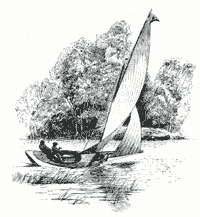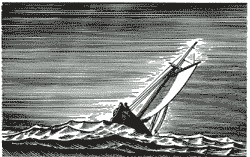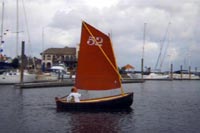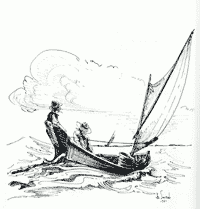DRESSING
SAILS
from Yacht Cruising by Claude Worth
submitted by Jamie Orr
Many different dressings are used by fishermen to preserve
their sails and to keep them supple in wet and cold weather.
Light summer sails are usually barked or tanned. These are
sometimes afterwards brushed over with paraffin (kerosene).
The Brixham men use a complicated mixture of linseed oil,
tallow, Stockholm tar, yellow ochre, etc. If yachts’
sails are to be dressed they may be either tanned, or dressed
with oil and ochre.
 Nets
are barked by passing them through a boiling solution of
cutch, one pound to each gallon of water. In 1902, I saw
the late Dr. P. W. Hughes barking his nets and using bichromate
of potassium as a fixer. I tried the same solution on some
light sails with disastrous result. Later, I made experiments
with samples of the lightest sail cloth to find a strength
of bichromate which would fix the cutch without injuring
the fabric. This is the recipe for light sails which are
not too large for the copper. Nets
are barked by passing them through a boiling solution of
cutch, one pound to each gallon of water. In 1902, I saw
the late Dr. P. W. Hughes barking his nets and using bichromate
of potassium as a fixer. I tried the same solution on some
light sails with disastrous result. Later, I made experiments
with samples of the lightest sail cloth to find a strength
of bichromate which would fix the cutch without injuring
the fabric. This is the recipe for light sails which are
not too large for the copper.
Boil in a copper 12 pounds of cutch and 12 gallons of water.
Dip the sail and let it soak for a few minutes. Then clean
out the copper and boil 4 or 5 ounces of bichromate of potassium
in 12 gallons of water. Dip the sail in again. Then rinse
it in water to remove the bichromate. If the bichromate
contains any free chromic acid it will destroy the sail.
It is therefore well to test the solution with litmus paper.
If the litmus paper turns red, add washing soda gradually
until it just begins to turn blue.
 Tanning
helps to preserve a sail. It does not make it stiff or heavy.
The tanned sail is of a brown colour which does not shew
dirty marks. But the canvas will be nearly as absorbent
as before, so that it is as stiff and heavy in wet weather
as an untanned sail. In a small vessel it is convenient
to have a balloon fore-staysail tanned, because it so often
has to be stowed wet. It is useful for a dinghy’s
sail also because it does not increase the weight. Tanning
helps to preserve a sail. It does not make it stiff or heavy.
The tanned sail is of a brown colour which does not shew
dirty marks. But the canvas will be nearly as absorbent
as before, so that it is as stiff and heavy in wet weather
as an untanned sail. In a small vessel it is convenient
to have a balloon fore-staysail tanned, because it so often
has to be stowed wet. It is useful for a dinghy’s
sail also because it does not increase the weight.
Oil and Ochre.—The method often employed by sail-makers
is to brush the sails on both sides with a mixture of linseed
oil, ochre, and water. The ochre and water form an emulsion
with the oil. When the water evaporates, the globules of
oil and particles of ochre are spread over the surface of
the canvas. But the oil only penetrates the fabric of the
canvas very slightly, and the tablings not at all. It therefore
does very little towards preserving the sails.
 A
good recipe for oil and ochre dressing is as follows:—Put
in a copper 5 gallons of the best raw linseed oil and 1¼
pounds of beeswax. Heat it until it begins to boil. Then
gradually add 20 lbs. Venetian red ochre and 10 lbs. “light
purple brown” ochre, and boil for five minutes, stirring
all the time. When cool enough, add 10 gallons of the best
paraffin lamp oil. Spread the dry sails on a clean floor
or a clean shingle beach. Keep the contents of the copper
constantly stirred. Brush it on both sides of the sails
with a large paint scrubber, working the mixture well into
the tablings. The sails should be temporarily bent to spars
and hung up to dry in an open shed. Two days later they
should be moved a little so that the oil does not settle
in one place. They must be well ventilated while drying:
if left in a heap only for a few hours they may become heated,
and rot. After a fortnight they may be spread in the sun
to complete the drying process. These quantities will be
sufficient for 800 or 900 square feet of No. 6 flax canvas,
or for 1,200 square feet of cotton of equivalent weight.
Lighter canvas will, of course, require less. A
good recipe for oil and ochre dressing is as follows:—Put
in a copper 5 gallons of the best raw linseed oil and 1¼
pounds of beeswax. Heat it until it begins to boil. Then
gradually add 20 lbs. Venetian red ochre and 10 lbs. “light
purple brown” ochre, and boil for five minutes, stirring
all the time. When cool enough, add 10 gallons of the best
paraffin lamp oil. Spread the dry sails on a clean floor
or a clean shingle beach. Keep the contents of the copper
constantly stirred. Brush it on both sides of the sails
with a large paint scrubber, working the mixture well into
the tablings. The sails should be temporarily bent to spars
and hung up to dry in an open shed. Two days later they
should be moved a little so that the oil does not settle
in one place. They must be well ventilated while drying:
if left in a heap only for a few hours they may become heated,
and rot. After a fortnight they may be spread in the sun
to complete the drying process. These quantities will be
sufficient for 800 or 900 square feet of No. 6 flax canvas,
or for 1,200 square feet of cotton of equivalent weight.
Lighter canvas will, of course, require less.
 Since
the War the ochres have been obtainable ground in linseed
oil to a smooth stiff paste. This is much more convenient.
Less linseed oil is added. The proportions now are ochre
ground in oil 30 lbs., linseed oil 3 gallons, paraffin lamp
oil 10 gallons, beeswax or paraffin wax 1¼ lbs. About
4 ounces of dryers may be used in cold damp weather. Since
the War the ochres have been obtainable ground in linseed
oil to a smooth stiff paste. This is much more convenient.
Less linseed oil is added. The proportions now are ochre
ground in oil 30 lbs., linseed oil 3 gallons, paraffin lamp
oil 10 gallons, beeswax or paraffin wax 1¼ lbs. About
4 ounces of dryers may be used in cold damp weather.
These ochres give a rich red-brown colour. Very nearly
the same colour may be got by using 25 lbs. Venetian and
5 lbs. Indian red. Venetian red alone gives a brick red
colour. Yellow ochre may be used alone, but it gives an
unpleasant colour if used with any other ochre. Linseed
oil should be of the best quality, obtained direct from
a reliable firm. The best clear paraffin lamp oil should
be used, as it dries more quickly and leaves no unpleasant
smell behind. Oil and ochre, of course, add to the weight
of the canvas. Sails dressed by this method are durable,
supple, and waterproof so that they do not become stiff
and heavy in wet weather.
 New
sails should not be dressed until they are fully stretched.
It is generally best to keep them white for the first year.
If one has a crew or plenty of leisure to take care of the
sails it is seldom worth while to have them dressed. New
sails should not be dressed until they are fully stretched.
It is generally best to keep them white for the first year.
If one has a crew or plenty of leisure to take care of the
sails it is seldom worth while to have them dressed.
I have used this recipe many times before the War and have
never had any trouble: for example, the sails of Ianthe
II. were dressed by this method in 1905 and were still serviceable
in 1914. I have heard of cases since the War, in which sails
have been found to be rotten almost immediately after dressing
with oil and ochre, but I do not know what methods were
employed.
|

